radar sensor TOYOTA RAV4 PRIME 2021 Owners Manual (in English)
[x] Cancel search | Manufacturer: TOYOTA, Model Year: 2021, Model line: RAV4 PRIME, Model: TOYOTA RAV4 PRIME 2021Pages: 616, PDF Size: 34.66 MB
Page 309 of 616
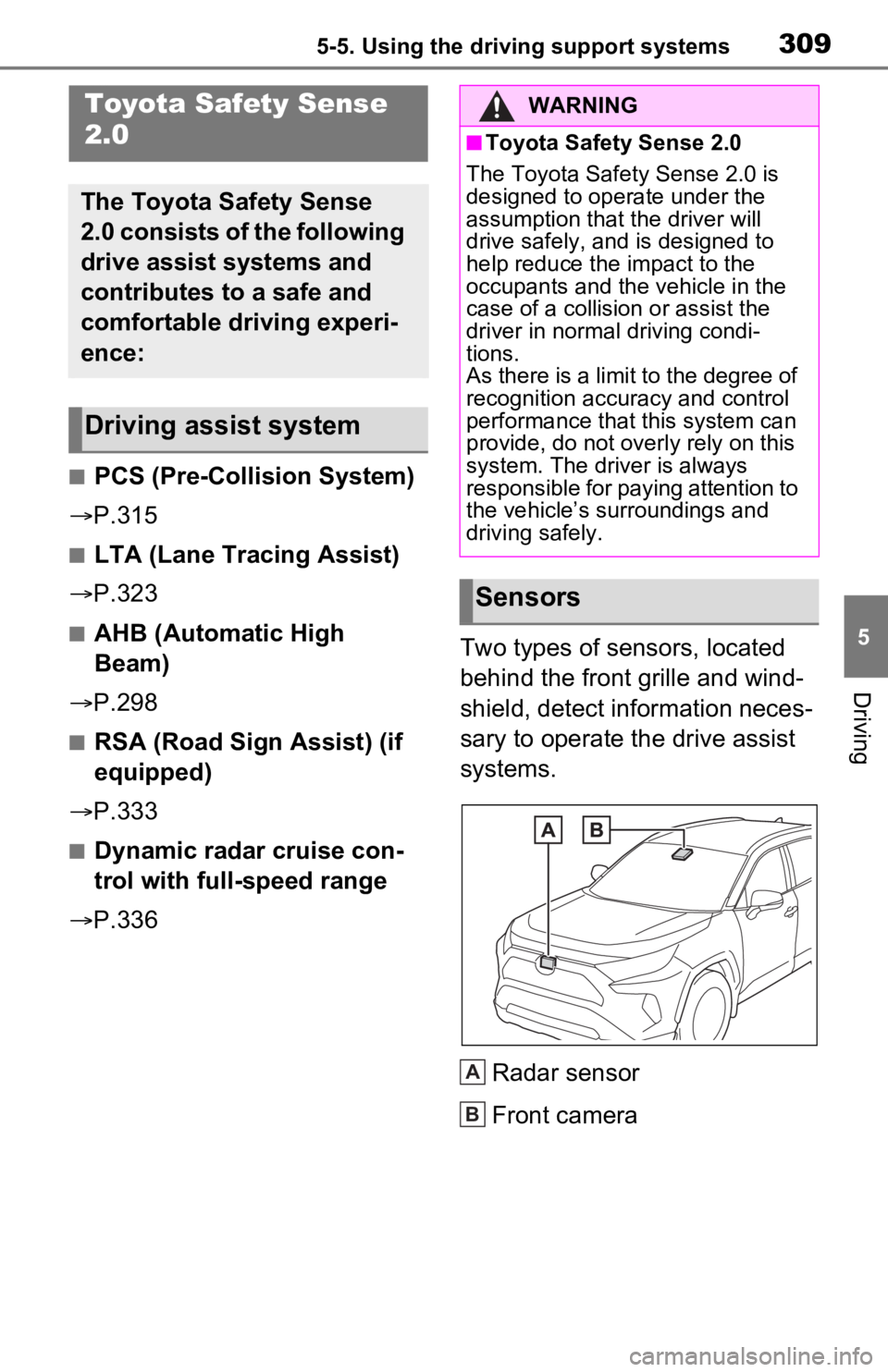
3095-5. Using the driving support systems
5
Driving
5-5.Using the driving support systems
Ō¢ĀPCS (Pre-Collision System)
’é« P.315
Ō¢ĀLTA (Lane Tracing Assist)
’é« P.323
Ō¢ĀAHB (Automatic High
Beam)
’é« P.298
Ō¢ĀRSA (Road Sign Assist) (if
equipped)
’é« P.333
Ō¢ĀDynamic radar cruise con-
trol with full-speed range
’é« P.336 Two types of sensors, located
behind the front grille and wind-
shield, detect information neces-
sary to operate the drive assist
systems.
Radar sensor
Front camera
Toyota Safety Sense
2.0
The Toyota Safety Sense
2.0 consists of the following
drive assist systems and
contributes to a safe and
comfortable driving experi-
ence:
Driving assist system
WARNING
Ō¢ĀToyota Safety Sense 2.0
The Toyota Safety Sense 2.0 is
designed to operate under the
assumption that the driver will
drive safely, and is designed to
help reduce the impact to the
occupants and the vehicle in the
case of a collision or assist the
driver in normal driving condi-
tions.
As there is a limit to the degree of
recognition accuracy and control
performance that this system can
provide, do not overly rely on this
system. The driver is always
responsible for paying attention to
the vehicleŌĆÖs su rroundings and
driving safely.
Sensors
A
B
Page 310 of 616
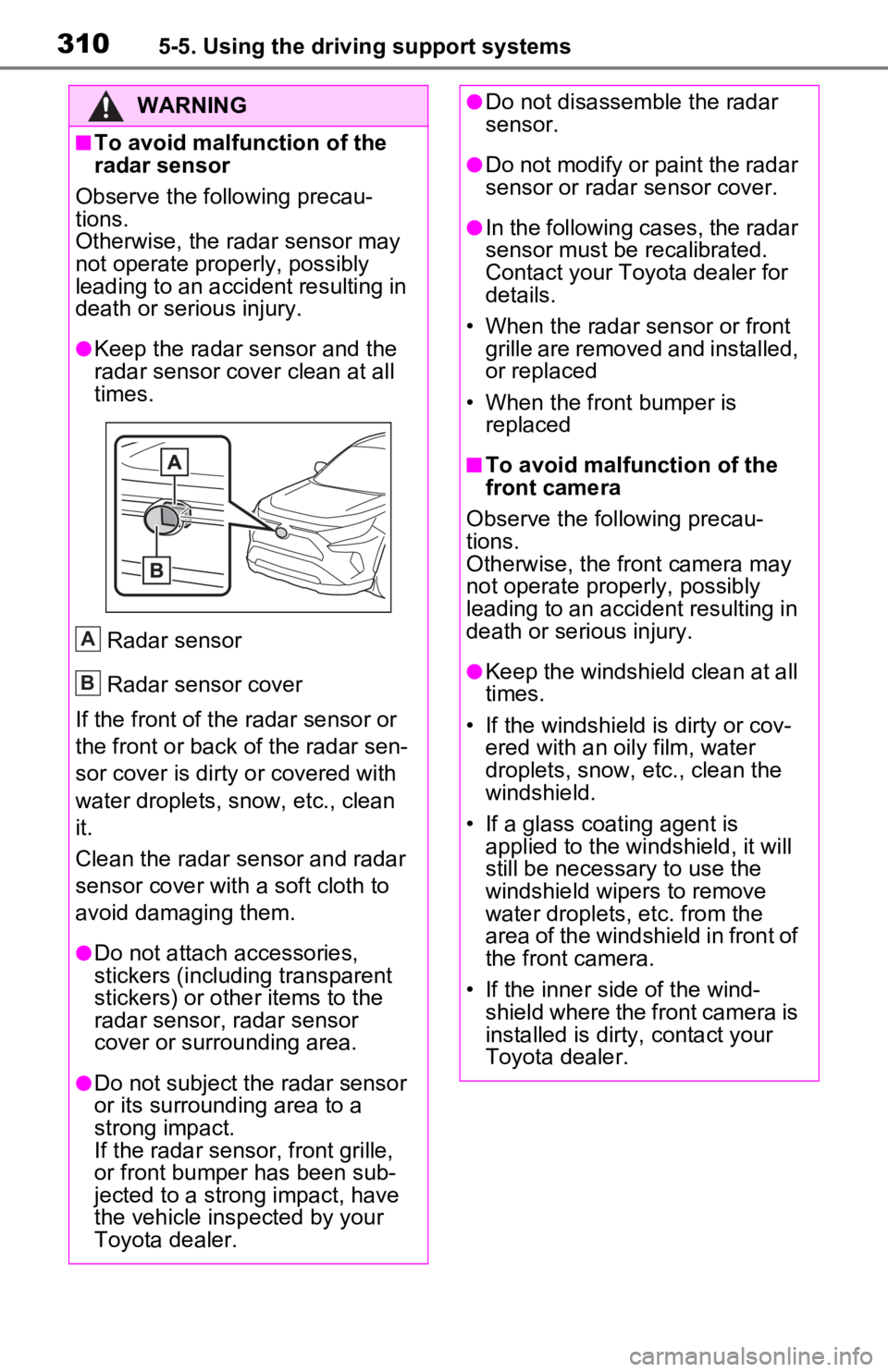
3105-5. Using the driving support systems
WARNING
Ō¢ĀTo avoid malfunction of the
radar sensor
Observe the following precau-
tions.
Otherwise, the radar sensor may
not operate properly, possibly
leading to an accident resulting in
death or serious injury.
ŌŚÅKeep the radar sensor and the
radar sensor cover clean at all
times.
Radar sensor
Radar sensor cover
If the front of the r adar sensor or
the front or back of the radar sen-
sor cover is dirty or covered with
water droplets, snow, etc., clean
it.
Clean the radar sensor and radar
sensor cover with a soft cloth to
avoid damaging them.
ŌŚÅDo not attach accessories,
stickers (including transparent
stickers) or other items to the
radar sensor, radar sensor
cover or surrounding area.
ŌŚÅDo not subject the radar sensor
or its surrounding area to a
strong impact.
If the radar sensor, fron t grille,
or front bumper has been sub-
jected to a strong impact, have
the vehicle insp ected by your
Toyota dealer.
A
B
ŌŚÅDo not disassemble the radar
sensor.
ŌŚÅDo not modify or paint the radar
sensor or radar sensor cover.
ŌŚÅIn the following cases, the radar
sensor must be recalibrated.
Contact your Toyota dealer for
details.
ŌĆó When the radar s ensor or front
grille are removed and installed,
or replaced
ŌĆó When the front bumper is replaced
Ō¢ĀTo avoid malfunction of the
front camera
Observe the following precau-
tions.
Otherwise, the f ront camera may
not operate properly, possibly
leading to an accident resulting in
death or serious injury.
ŌŚÅKeep the windshield clean at all
times.
ŌĆó If the windshield is dirty or cov-
ered with an o ily film, water
droplets, snow, etc., clean the
windshield.
ŌĆó If a glass coating agent is applied to the windshield, it will
still be necessary to use the
windshield wipers to remove
water droplets, etc. from the
area of the windshield in front of
the front camera.
ŌĆó If the inner side of the wind- shield where the front camera is
installed is dirty, contact your
Toyota dealer.
Page 314 of 616
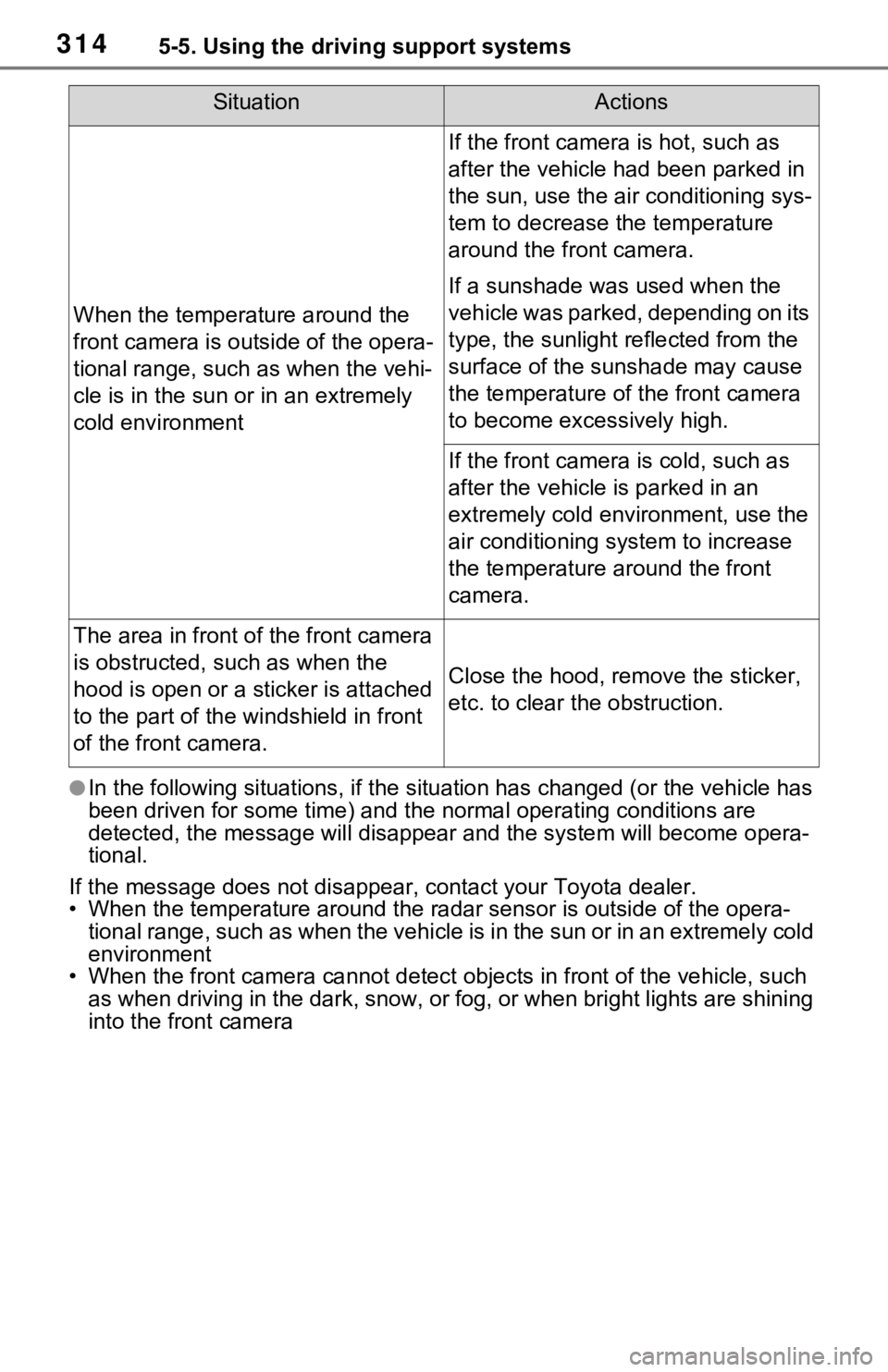
3145-5. Using the driving support systems
ŌŚÅIn the following situations, if the situation has changed (or the vehicle has
been driven for some time) and the normal operating conditions are
detected, the message will disappear and the system will become opera-
tional.
If the message does not disapp ear, contact your Toyota dealer.
ŌĆó When the temperature around the radar sensor is outside of the opera-
tional range, such as when the vehicle is in the sun or in an e xtremely cold
environment
ŌĆó When the front camera cannot d etect objects in front of the vehicle, such
as when driving in the dark, sno w, or fog, or when bright lights are shining
into the front camera
When the temperature around the
front camera is outside of the opera-
tional range, such as when the vehi-
cle is in the sun or in an extremely
cold environment
If the front camera is hot, such as
after the vehicle had been parked in
the sun, use the air conditioning sys-
tem to decrease the temperature
around the front camera.
If a sunshade was used when the
vehicle was parked, depending on its
type, the sunlight reflected from the
surface of the sunshade may cause
the temperature of the front camera
to become excessively high.
If the front camera is cold, such as
after the vehicle is parked in an
extremely cold environment, use the
air conditioning system to increase
the temperature around the front
camera.
The area in front o f the front camera
is obstructed, such as when the
hood is open or a sticker is attached
to the part of the win dshield in front
of the front camera.
Close the hood, rem ove the sticker,
etc. to clear the obstruction.
SituationActions
Page 315 of 616
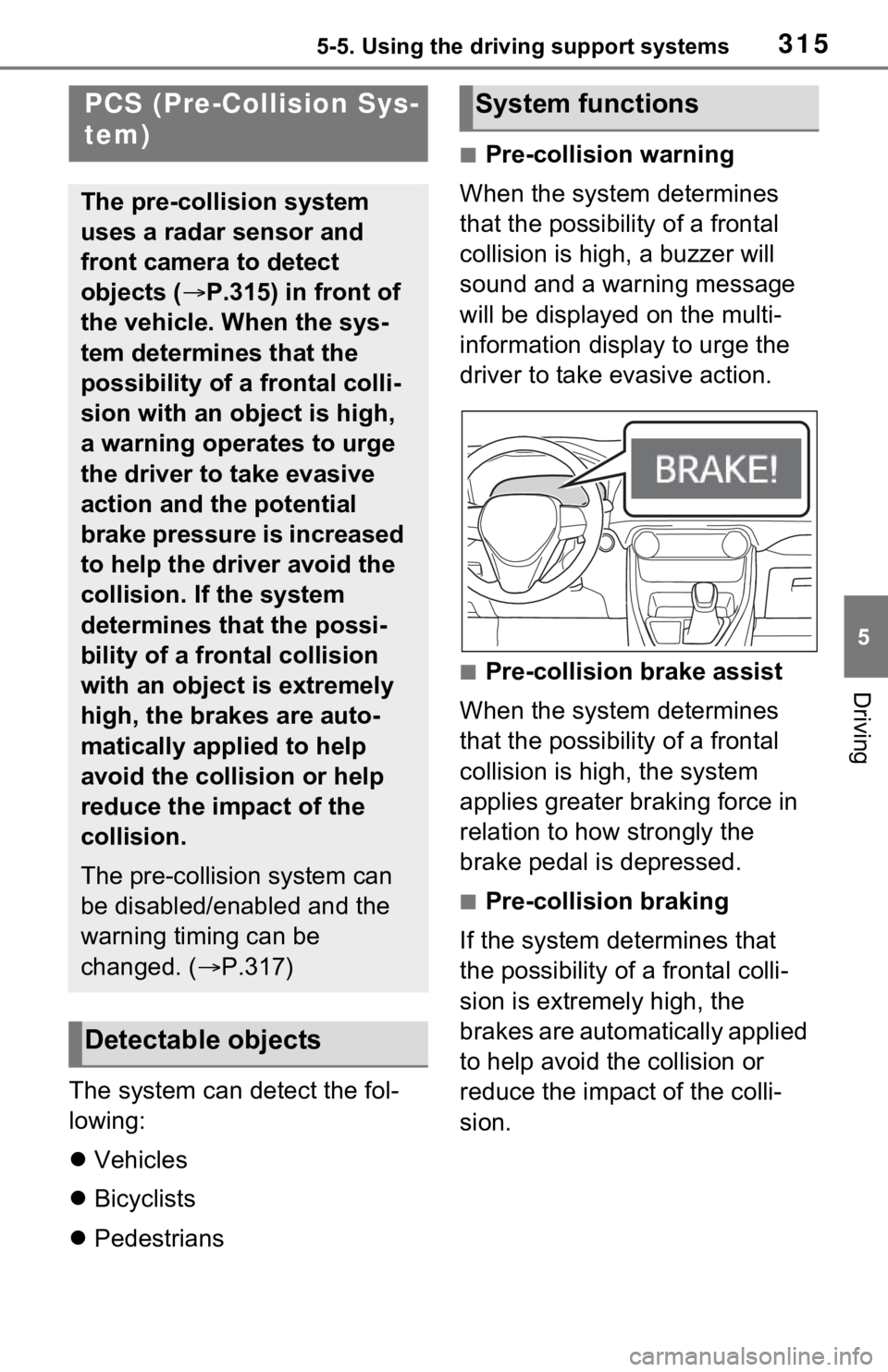
3155-5. Using the driving support systems
5
Driving
The system can detect the fol-
lowing:
’ü¼Vehicles
’ü¼ Bicyclists
’ü¼ Pedestrians
Ō¢ĀPre-collision warning
When the system determines
that the possibility of a frontal
collision is high, a buzzer will
sound and a warning message
will be displayed on the multi-
information display to urge the
driver to take evasive action.
Ō¢ĀPre-collision brake assist
When the system determines
that the possibility of a frontal
collision is high, the system
applies greater braking force in
relation to how strongly the
brake pedal is depressed.
Ō¢ĀPre-collision braking
If the system determines that
the possibility of a frontal colli-
sion is extremely high, the
brakes are automatically applied
to help avoid the collision or
reduce the impact of the colli-
sion.
PCS (Pre-Collision Sys-
tem)
The pre-collision system
uses a radar sensor and
front camera to detect
objects ( ’é«P.315) in front of
the vehicle. When the sys-
tem determines that the
possibility of a frontal colli-
sion with an object is high,
a warning operates to urge
the driver to take evasive
action and the potential
brake pressure is increased
to help the driver avoid the
collision. If the system
determines that the possi-
bility of a frontal collision
with an object is extremely
high, the brakes are auto-
matically applied to help
avoid the collision or help
reduce the impact of the
collision.
The pre-collision system can
be disabled/enabled and the
warning timing can be
changed. ( ’é«P.317)
Detectable objects
System functions
Page 320 of 616
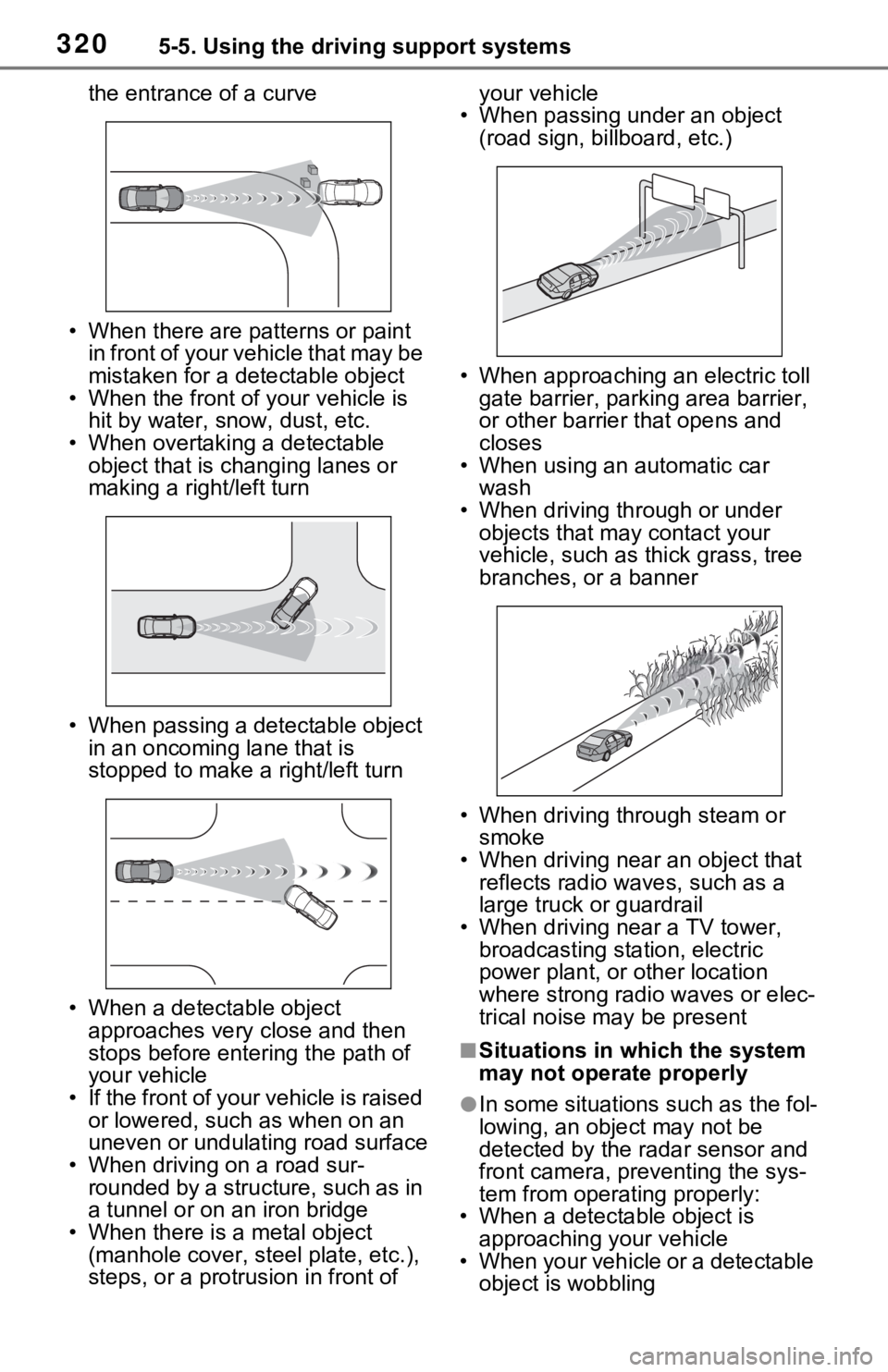
3205-5. Using the driving support systems
the entrance of a curve
ŌĆó When there are patterns or paint in front of your vehicle that may be
mistaken for a detectable object
ŌĆó When the front of your vehicle is hit by water, snow, dust, etc.
ŌĆó When overtaking a detectable object that is ch anging lanes or
making a right/left turn
ŌĆó When passing a detectable object in an oncoming lane that is
stopped to make a right/left turn
ŌĆó When a detectable object approaches very close and then
stops before entering the path of
your vehicle
ŌĆó If the front of your vehicle is raised
or lowered, such as when on an
uneven or undulating road surface
ŌĆó When driving on a road sur-
rounded by a structure, such as in
a tunnel or on an iron bridge
ŌĆó When there is a metal object
(manhole cover, steel plate, etc.),
steps, or a protrusion in front of your vehicle
ŌĆó When passing under an object (road sign, billboard, etc.)
ŌĆó When approaching an electric toll gate barrier, parking area barrier,
or other barrier that opens and
closes
ŌĆó When using an automatic car wash
ŌĆó When driving through or under objects that may contact your
vehicle, such as thick grass, tree
branches, or a banner
ŌĆó When driving through steam or smoke
ŌĆó When driving near an object that reflects radio waves, such as a
large truck or guardrail
ŌĆó When driving near a TV tower, broadcasting station, electric
power plant, or other location
where strong radio waves or elec-
trical noise may be present
Ō¢ĀSituations in which the system
may not operate properly
ŌŚÅIn some situations such as the fol-
lowing, an object may not be
detected by the radar sensor and
front camera, pre venting the sys-
tem from opera ting properly:
ŌĆó When a detectable object is approaching your vehicle
ŌĆó When your vehicle or a detectable
object is wobbling
Page 322 of 616
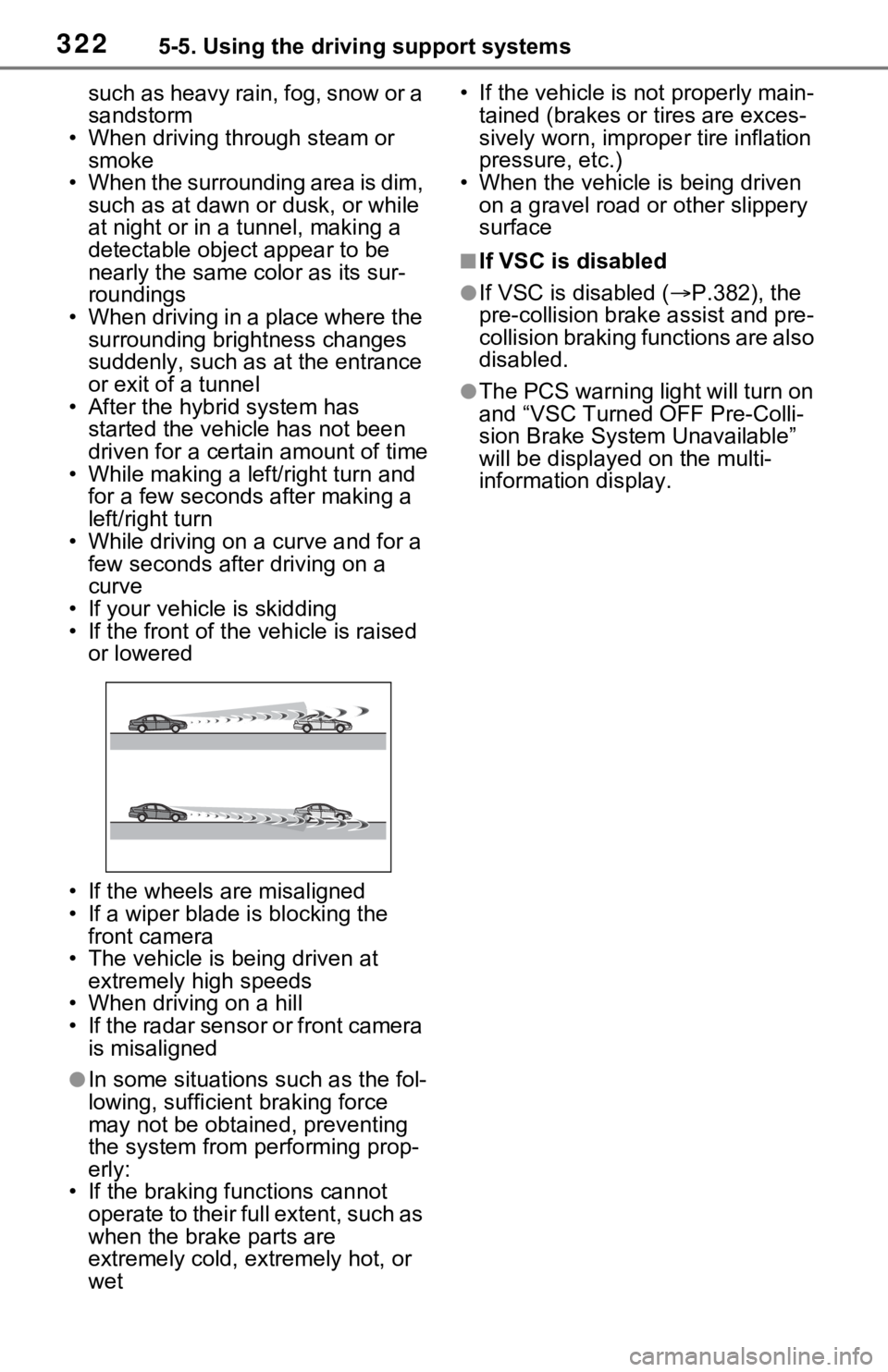
3225-5. Using the driving support systems
such as heavy rain, fog, snow or a
sandstorm
ŌĆó When driving through steam or smoke
ŌĆó When the surrounding area is dim, such as at dawn or dusk, or while
at night or in a t unnel, making a
detectable object appear to be
nearly the same color as its sur-
roundings
ŌĆó When driving in a place where the surrounding brightness changes
suddenly, such as at the entrance
or exit of a tunnel
ŌĆó After the hybrid system has started the vehicle has not been
driven for a certain amount of time
ŌĆó While making a left/right turn and for a few seconds after making a
left/right turn
ŌĆó While driving on a curve and for a
few seconds after driving on a
curve
ŌĆó If your vehicle is skidding
ŌĆó If the front of the vehicle is raised or lowered
ŌĆó If the wheels are misaligned
ŌĆó If a wiper blade is blocking the front camera
ŌĆó The vehicle is being driven at extremely high speeds
ŌĆó When driving on a hill
ŌĆó If the radar sensor or front camera is misaligned
ŌŚÅIn some situations such as the fol-
lowing, sufficien t braking force
may not be obtained, preventing
the system from performing prop-
erly:
ŌĆó If the braking functions cannot operate to their full extent, such as
when the brake parts are
extremely cold, extremely hot, or
wet ŌĆó If the vehicle is not properly main-
tained (brakes or tires are exces-
sively worn, imprope r tire inflation
pressure, etc.)
ŌĆó When the vehicle is being driven on a gravel road or other slippery
surface
Ō¢ĀIf VSC is disabled
ŌŚÅIf VSC is disabled ( ’é«P.382), the
pre-collision brak e assist and pre-
collision braking functions are also
disabled.
ŌŚÅThe PCS warning light will turn on
and ŌĆ£VSC Turned OFF Pre-Colli-
sion Brake System UnavailableŌĆØ
will be displayed on the multi-
information display.
Page 337 of 616
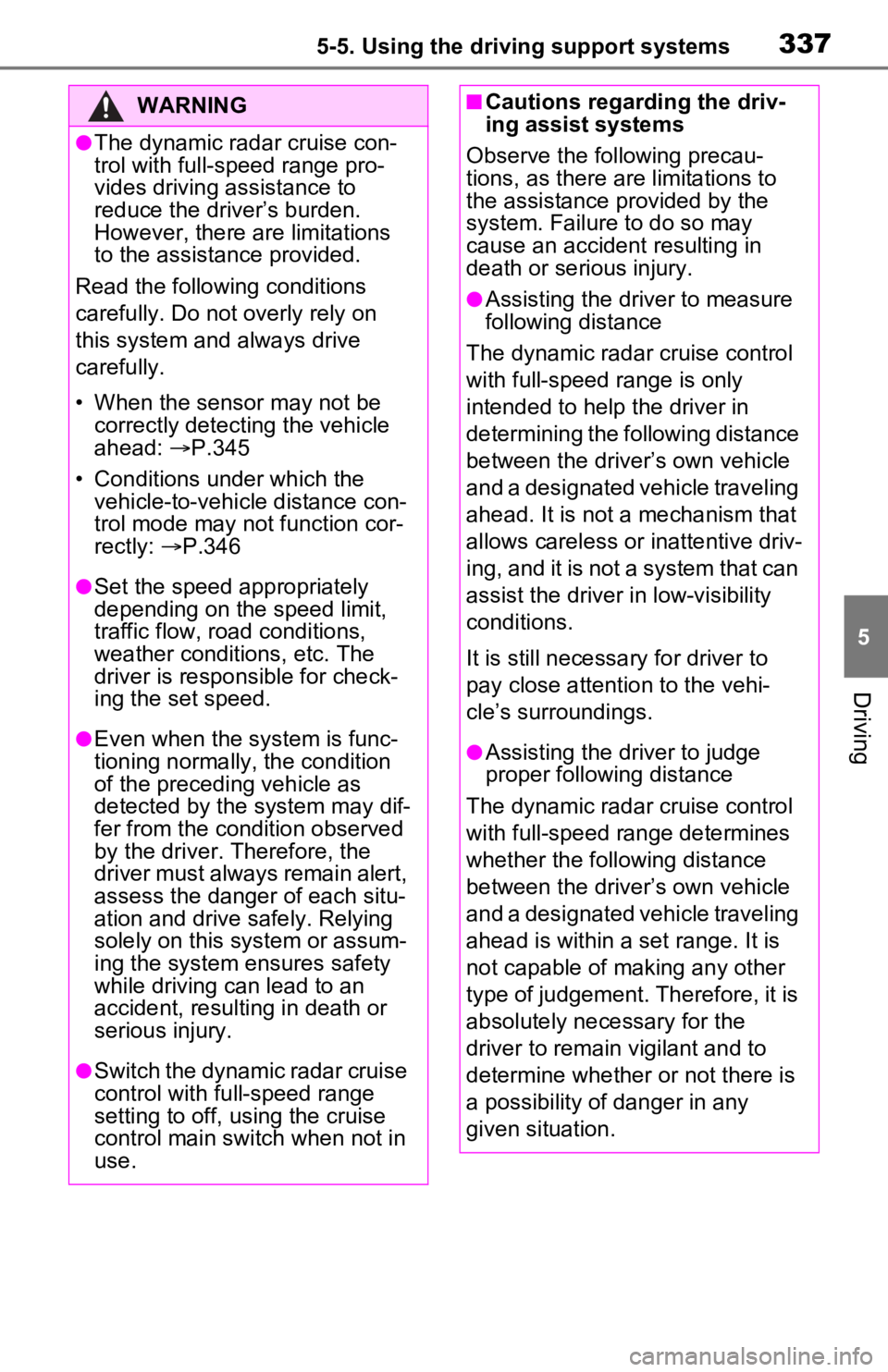
3375-5. Using the driving support systems
5
Driving
WARNING
ŌŚÅThe dynamic radar cruise con-
trol with full-speed range pro-
vides driving assistance to
reduce the driverŌĆÖs burden.
However, there are limitations
to the assistance provided.
Read the following conditions
carefully. Do not overly rely on
this system and always drive
carefully.
ŌĆó When the sensor may not be correctly detect ing the vehicle
ahead: ’é«P.345
ŌĆó Conditions under which the vehicle-to-vehicle distance con-
trol mode may not function cor-
rectly: ’é«P.346
ŌŚÅSet the speed appropriately
depending on the speed limit,
traffic flow, road conditions,
weather conditions, etc. The
driver is respon sible for check-
ing the set speed.
ŌŚÅEven when the system is func-
tioning normally, the condition
of the preceding vehicle as
detected by the system may dif-
fer from the condition observed
by the driver. Therefore, the
driver must always remain alert,
assess the danger of each situ-
ation and drive safely. Relying
solely on this system or assum-
ing the system ensures safety
while driving can lead to an
accident, resulting in death or
serious injury.
ŌŚÅSwitch the dynamic radar cruise
control with full-speed range
setting to off, using the cruise
control main swi tch when not in
use.
Ō¢ĀCautions regarding the driv-
ing assist systems
Observe the following precau-
tions, as there ar e limitations to
the assistance provided by the
system. Failure to do so may
cause an accident resulting in
death or serious injury.
ŌŚÅAssisting the driver to measure
following distance
The dynamic radar cruise control
with full-speed range is only
intended to help the driver in
determining the following distance
between the driverŌĆÖs own vehicle
and a designated vehicle traveling
ahead. It is not a mechanism that
allows careless or inattentive driv-
ing, and it is not a system that can
assist the driver in low-visibility
conditions.
It is still necessa ry for driver to
pay close attenti on to the vehi-
cleŌĆÖs surroundings.
ŌŚÅAssisting the driver to judge
proper following distance
The dynamic radar cruise control
with full-speed range determines
whether the following distance
between the driverŌĆÖs own vehicle
and a designated vehicle traveling
ahead is within a set range. It is
not capable of making any other
type of judgement. Therefore, it is
absolutely necessary for the
driver to remain vigilant and to
determine whether or not there is
a possibility of danger in any
given situation.
Page 338 of 616
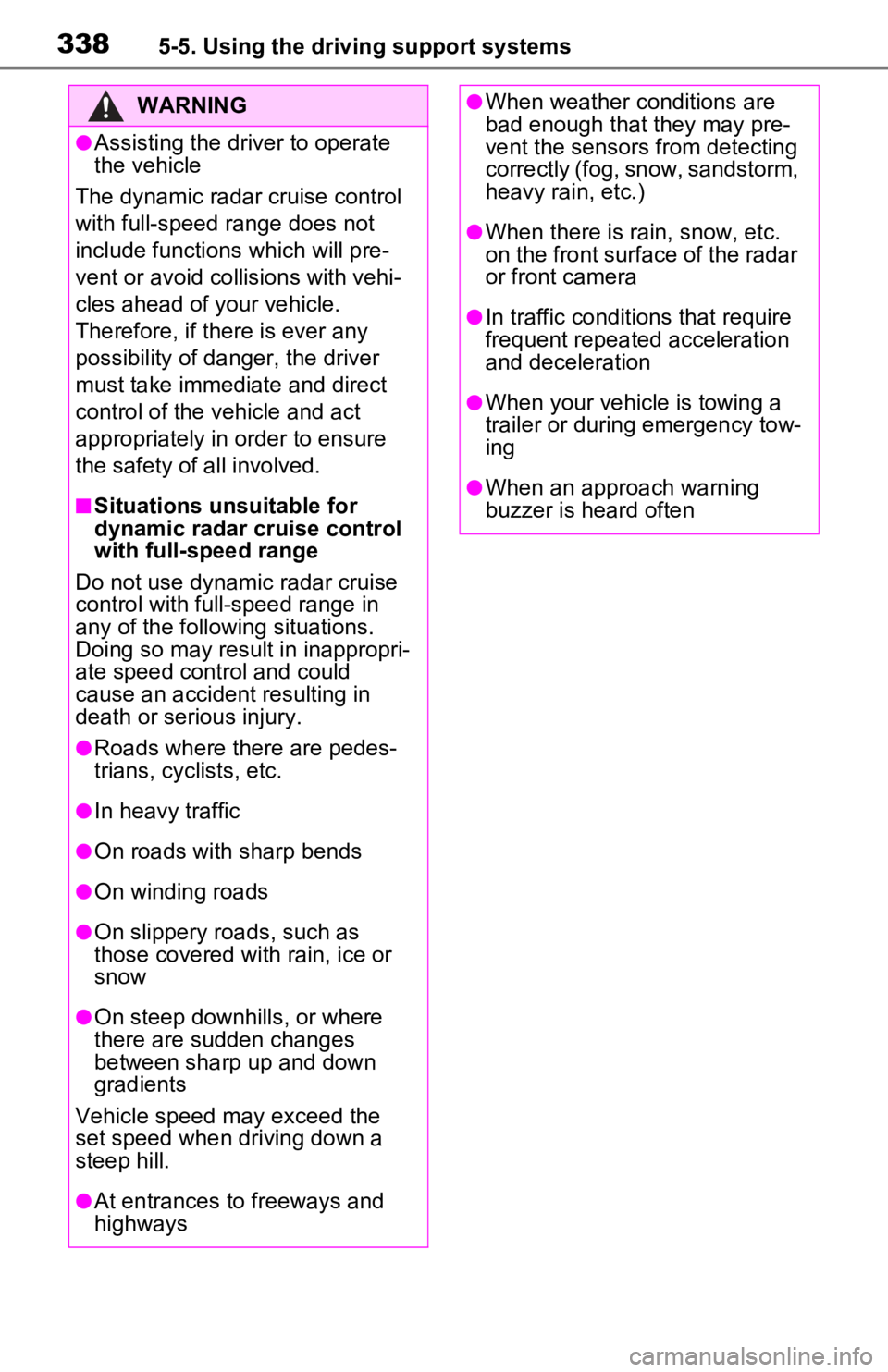
3385-5. Using the driving support systems
WARNING
ŌŚÅAssisting the driver to operate
the vehicle
The dynamic radar cruise control
with full-speed range does not
include function s which will pre-
vent or avoid collisions with vehi-
cles ahead of your vehicle.
Therefore, if there is ever any
possibility of da nger, the driver
must take immediate and direct
control of the vehicle and act
appropriately in order to ensure
the safety of all involved.
Ō¢ĀSituations unsuitable for
dynamic radar cruise control
with full-speed range
Do not use dynamic radar cruise
control with full-speed range in
any of the following situations.
Doing so may result in inappropri-
ate speed control and could
cause an accident resulting in
death or serious injury.
ŌŚÅRoads where there are pedes-
trians, cyclists, etc.
ŌŚÅIn heavy traffic
ŌŚÅOn roads with sharp bends
ŌŚÅOn winding roads
ŌŚÅOn slippery roads, such as
those covered with rain, ice or
snow
ŌŚÅOn steep downhills, or where
there are sudden changes
between sharp up and down
gradients
Vehicle speed may exceed the
set speed when driving down a
steep hill.
ŌŚÅAt entrances to freeways and
highways
ŌŚÅWhen weather conditions are
bad enough that they may pre-
vent the sensors from detecting
correctly (fog, snow, sandstorm,
heavy rain, etc.)
ŌŚÅWhen there is rain, snow, etc.
on the front surface of the radar
or front camera
ŌŚÅIn traffic conditi ons that require
frequent repeated acceleration
and deceleration
ŌŚÅWhen your vehicle is towing a
trailer or during emergency tow-
ing
ŌŚÅWhen an approach warning
buzzer is heard often
Page 345 of 616
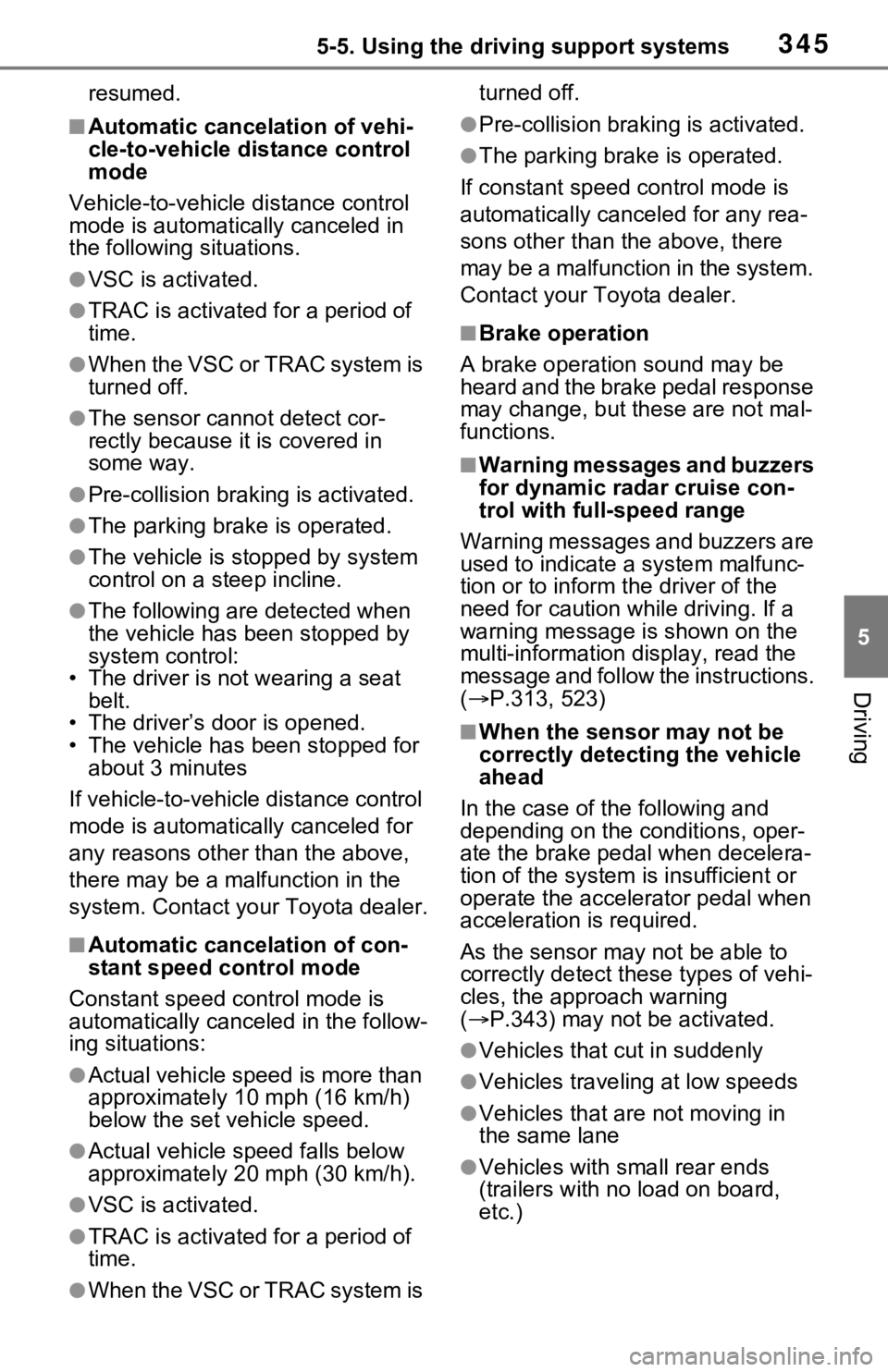
3455-5. Using the driving support systems
5
Driving
resumed.
Ō¢ĀAutomatic cancelation of vehi-
cle-to-vehicle distance control
mode
Vehicle-to-vehicle distance control
mode is automatically canceled in
the following situations.
ŌŚÅVSC is activated.
ŌŚÅTRAC is activated for a period of
time.
ŌŚÅWhen the VSC or TRAC system is
turned off.
ŌŚÅThe sensor cannot detect cor-
rectly because i t is covered in
some way.
ŌŚÅPre-collision braking is activated.
ŌŚÅThe parking brake is operated.
ŌŚÅThe vehicle is stopped by system
control on a steep incline.
ŌŚÅThe following are detected when
the vehicle has been stopped by
system control:
ŌĆó The driver is not wearing a seat belt.
ŌĆó The driverŌĆÖs door is opened.
ŌĆó The vehicle has been stopped for about 3 minutes
If vehicle-to-vehicle distance control
mode is automatically canceled for
any reasons other than the above,
there may be a malfunction in the
system. Contact your Toyota dealer.
Ō¢ĀAutomatic cancelation of con-
stant speed control mode
Constant speed control mode is
automatically cance led in the follow-
ing situations:
ŌŚÅActual vehicle speed is more than
approximately 10 mph (16 km/h)
below the set vehicle speed.
ŌŚÅActual vehicle speed falls below
approximately 20 mph (30 km/h).
ŌŚÅVSC is activated.
ŌŚÅTRAC is activated for a period of
time.
ŌŚÅWhen the VSC or TRAC system is turned off.
ŌŚÅPre-collision braking is activated.
ŌŚÅThe parking brake is operated.
If constant speed control mode is
automatically canceled for any rea-
sons other than the above, there
may be a malfunction in the system.
Contact your Toyota dealer.
Ō¢ĀBrake operation
A brake operation sound may be
heard and the brake pedal response
may change, but these are not mal-
functions.
Ō¢ĀWarning messages and buzzers
for dynamic radar cruise con-
trol with full-speed range
Warning messages and buzzers are
used to indicate a system malfunc-
tion or to inform the driver of the
need for caution while driving. If a
warning message is shown on the
multi-information display, read the
message and follow the instructions.
( ’é« P.313, 523)
Ō¢ĀWhen the sensor may not be
correctly detecting the vehicle
ahead
In the case of the following and
depending on the conditions, oper-
ate the brake pedal when decelera-
tion of the system is insufficient or
operate the accelerator pedal when
acceleration is required.
As the sensor may not be able to
correctly detect th ese types of vehi-
cles, the approach warning
( ’é« P.343) may not be activated.
ŌŚÅVehicles that cut in suddenly
ŌŚÅVehicles traveling at low speeds
ŌŚÅVehicles that are not moving in
the same lane
ŌŚÅVehicles with small rear ends
(trailers with no load on board,
etc.)
Page 350 of 616
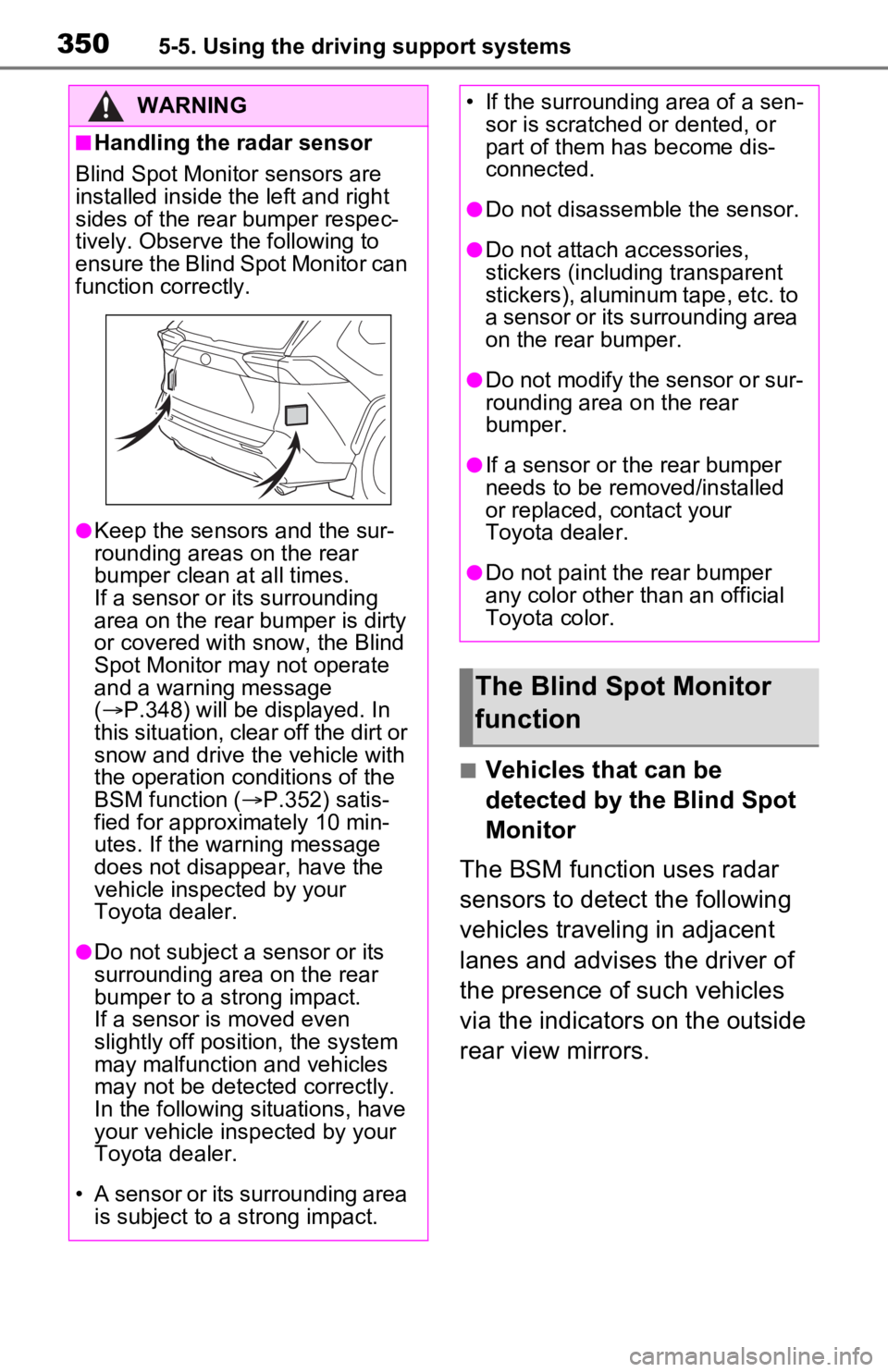
3505-5. Using the driving support systems
Ō¢ĀVehicles that can be
detected by the Blind Spot
Monitor
The BSM function uses radar
sensors to detect the following
vehicles traveling in adjacent
lanes and advises the driver of
the presence of such vehicles
via the indicators on the outside
rear view mirrors.
WARNING
Ō¢ĀHandling the radar sensor
Blind Spot Monitor sensors are
installed inside the left and right
sides of the rear bumper respec-
tively. Observe the following to
ensure the Blind Spot Monitor can
function correctly.
ŌŚÅKeep the sensors and the sur-
rounding areas on the rear
bumper clean at all times.
If a sensor or its surrounding
area on the rear bumper is dirty
or covered with snow, the Blind
Spot Monitor may not operate
and a warning message
( ’é« P.348) will be displayed. In
this situation, clear off the dirt or
snow and drive the vehicle with
the operation conditions of the
BSM function ( ’é«P.352) satis-
fied for approxi mately 10 min-
utes. If the warning message
does not disappear, have the
vehicle inspected by your
Toyota dealer.
ŌŚÅDo not subject a sensor or its
surrounding area on the rear
bumper to a strong impact.
If a sensor is moved even
slightly off position, the system
may malfunction and vehicles
may not be detected correctly.
In the following si tuations, have
your vehicle inspected by your
Toyota dealer.
ŌĆó A sensor or its surrounding area is subject to a strong impact.
ŌĆó If the surrounding area of a sen-
sor is scratched or dented, or
part of them h as become dis-
connected.
ŌŚÅDo not disassemble the sensor.
ŌŚÅDo not attach a ccessories,
stickers (including transparent
stickers), aluminum tape, etc. to
a sensor or its surrounding area
on the rear bumper.
ŌŚÅDo not modify the sensor or sur-
rounding area on the rear
bumper.
ŌŚÅIf a sensor or the rear bumper
needs to be removed/installed
or replaced, contact your
Toyota dealer.
ŌŚÅDo not paint the rear bumper
any color other than an official
Toyota color.
The Blind Spot Monitor
function